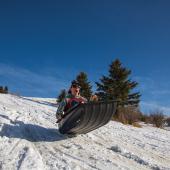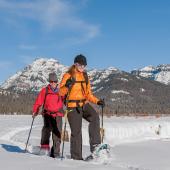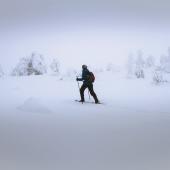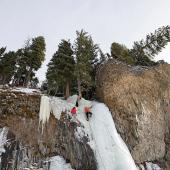Stepping Into the Wild
As if in a dream, I’m gliding down a snowfield, the silence caressed by the gentle sound of the powder snow moving beneath my feet. The slope is so steep that, in reality, I’m falling, but the pillow of snow on which I’m balanced, and the shear volume of snow, cushions all hazards.
The momentum of my body carries me down, but the snow moves fluidly as I perch on a billowing white wave. In seconds I plunge into the trees, but the slightly flatter gradient allows me to choose an open lane and shift my weight as I plant a pole and take a short step to change direction. I now slide through a forest corridor and treeless security.
For most of the glide I hold my poles high to minimize drag, but they’re a big part of my stability, and as the slope gradient softens all the more I maintain my speed by planting a pole and simultaneously taking an advancing step. With the leading foot braced and bearing most of my weight, and the trailing leg bent at the knee, I surf the hillside in a series of steps, each one a 10-yard glide.
I’ve descended hundreds of feet, and now, either to catch my breath or just to savor the moment, I stop and look uphill at my snow trail as if it’s some type of valuable creation. If nothing else, it is evidence of presence. The exhilaration is as extreme as the landscape and I’m giddy from the combination of abundant snow, exertion, natural beauty, and a successful “run.” This is snowshoeing at it’s finest. I’ve traversed terrain like this numerous times, in an attempt to find the best range of snowshoe use conditions, and along the way I’ve found snowshoeing to be as exciting, exhilarating, easy, and fun as any other form of outdoor recreation.
It’s obvious snowshoeing is rising exponentially in popularity. From the casual snow-walker to the backcountry snowboarder, snowshoes are easy to store, transport, use, and maintain. One thing is certain: if you can walk, you can snowshoe. Snowshoeing is also appropriate for most ages and is a great family activity.
Here is the crux: snowshoeing can be as physical or as laid back as you desire; that is, it can range from a casual nature stroll to intense mountaineering. Functionally, snowshoes are the most efficient and reliable way to access the pure perfection of winter wilderness.
Keep in mind, we’re discussing very simple technology here. Are you worried about falling down? The snowshoe itself is a simple platform for the purpose of weight distribution. Distribution of weight reduces sinking into the snow, and on some snow types, this platform can actually provide additional stability to the snowshoe user, minimizing the possibility of a fall.
Compared to other outdoor gear, snowshoes are relatively inexpensive — a person can find a new pair for around $200.00. Once purchased, snowshoes are like a good book; each time used, familiar and new perspectives appear. There’s a reason you rarely see used snowshoes for sale. Modern synthetic designs essentially take no maintenance, so they can last a lifetime. Besides, if you live in snow country, you never know when you may need this potentially critical piece of “survival gear.”
‘Shoeing Through the Ages
Okay, let’s take it from the top. We all know that snowshoes, in some fashion, have been used for thousands of years. In North America, snowshoes, not skis, were extensively used and perfected by Native Americans in the northern coniferous forests and some of the northern temperate deciduous forests (New England, for example). They needed to travel over the snow for a variety of reasons, but the primary reason was to hunt — and the guys who perfected snowshoes were hunters.
Think about the not-particularly-mountainous portions of eastern Canada, such as Quebec, and New England. Now think of the hunters’ prey. In the dense willow of a river delta, in the dark spruce and fir forests, a hunter may expect to see the solitary dark coat of a moose. In places like this, unless on an established trail, it can be impossible to walk or even ski. The snowshoe, however, kept the hunter atop the snow and allowed him to move silently, and thus was ideal for hunting and tracking the winding trail of big game like moose and deer.
Times have changed, and few of us rely on the success of a winter hunt for survival. But many of us do feel a need to escape the confines of our more urban existence, and to make rejuvenating contact with the natural winter landscape. In the United States, the forestlands of New England harbored community snowshoe events and activities well into the 1930s, when downhill skiing ultimately surpassed snowshoeing in general interest. While there has always been a place in snow country for snowshoes (other than the pizza parlor wall), use has dramatically increased during the past ten years. Certainly, aging “boomers” are attracted to the ease and flexible intensity of snowshoe use, but the real advantage is that snowshoes, by the very nature of optimum use, encourage a pristine nature-based experience.
Snowshoe Design
Older traditional snowshoes have been much maligned by the contemporary snowshoe industry. They are often described as unwieldy and heavy. The reality is that traditional shoes (with synthetic webbing) are still the best choice for relatively flat and densely vegetated areas. The old-style webbing, as opposed to the contemporary complete deck, provides more surface area with less weight, and the traditional ash frame is very strong and lightweight.
However, the hard truth for nostalgic aesthetes like me is that contemporary, synthetic shoes are indeed better in certain applications. Fortunately for us western Montana residents, the ideal application for synthetic shoes is in mountains: dense forest and steep terrain. Right now manufacturers are promoting the very small and maneuverable racing snowshoe. This “running shoe” design can be great on snow-packed trails, but forget it on rarely traveled deep powder. For mountaineering and breaking trail you’ll want a larger snowshoe. I find that in general, most people purchase snowshoes that are too small for fresh powder applications. Of course, when the powder is light and deep, no snowshoe may seem big enough!
Most contemporary designs are shaped like a long oval. Often called a “modified bear paw,” these long oval shoes minimize stepping on your own shoes, and are easy to walk in. Most modern designs also incorporate a large metal cleat under the foot, which provides traction and sure grip. The binding, an equally important feature of every snowshoe, slips over your winter footwear to fasten your foot to the snowshoe. All good binding designs allow for flexibility of the foot at the toe so a complete step and “push off” can be made when walking. When purchasing, try bindings on and examine them for weak points. Be particularly critical of plastics, which may become brittle in very cold temperatures. Make sure you can fasten and release bindings while wearing gloves or mittens.
Poles can also be a valuable piece of equipment, assisting with balance, minimizing pressure on the shoe (and thereby reducing your chances of sinking in some situations), can help provide forward momentum, can be useful in getting up if you’ve fallen in deep powder, and some can even be used as avalanche probes. I prefer adjustable poles because I can vary pole length depending upon steepness of slope.
Safety on Snowshoes
As always, when recreating outdoors, particularly in winter, certain safety precautions should be taken. If you’re going to go so far that you can’t crawl back, take these things: knife, nylon cord (enough to create a new deck or binding if need be), compass, large space blanket, fire and fire starter (disposable lighter and candle are good). It’s also a good idea to consider extra clothes, food, water, wind- and water-proof shell, heavy hat, sunglasses, sunscreen, first aid kit, and an avalanche probe & shovel.
Many folks are rightly concerned about avalanches. Learn to identify avalanche-prone areas. Local avalanche safety classes are available. Particularly be on the lookout for “terrain traps” which can be small and isolated, but which can hold enough snow in a precarious position to bury someone who happens to be in the wrong place at the wrong time.
Get Real Gone
Snowshoe design, snow conditions, level of physical intensity desired, and the landscape govern where to go. I generally snowshoe in areas where I can take maximum advantage of the snowshoes, and have minimal contact with other, sometimes faster and louder, forms of recreation. By heading into the densest forests I immediately leave skiers and snowmobiles behind. One of the most impressive features of snowshoeing is being able to walk through forests which would be impassable with deadfall in summer season, but which are parklike in winter, with downed trees completely covered with snow. Additionally, due to the metal cramponlike cleat under the foot, snowshoes can be used to climb extremely steep slopes and "ski" down the other side. Remember, snowshoeing is a “wilderness” travel technique. You can’t find untrammeled wilderness if you follow in the tracks of the crowd. So while I may park at a public lands trailhead, I rarely follow the constructed trail. More likely, I’ll head perpendicular to the route the developed trail follows.
These less-visited forest areas are often some of the best and least-disturbed wildlife habitat. Following tracks and other “sign” can be a great adventure. Among the most easily tracked but least frequently seen animals are the predators. Mountain lions, bobcats, and even lynx have an easily recognizable track and track pattern. Likewise the members of the weasel family (marten, ermine, wolverine) also have easily learned and recognized tracks and track patterns. To follow these guys, even for a few yards, can lead to wonderful natural discoveries and is a great children’s activity.
Of course, wildlife is a public resource and a public responsibility as well. So it is appropriate to be considerate of wildlife in winter and to minimize your impact on winter-stressed animals. For example, avoid known wintering areas for herds of deer and elk. This doesn’t, however, preclude enjoying them from a secure distance, so take binoculars with you and scan ahead for wildlife.
Snowshoeing is still the subtle, contemplative winter activity which has attracted so many people; but it is also, finally, being recognized as equally active and playful. Whether going solo, or with friends & family, you’ll find a place for snowshoeing within yourself and within the vast, untraveled landscape of a Montana winter.
Ken Sinay is a wildlife biologist and director of Yellowstone Safari Company and can be reached at [email protected].











